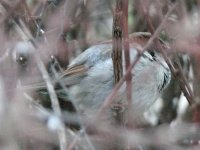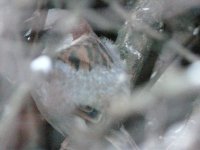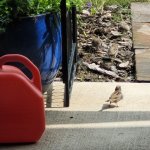
(Sorry for the title and clickbait; I wanted to put all the keywords in it.)
I've noticed that a significant proportion of House Sparrows of both sexes in the city centre of Warsaw (perhaps not representative of the whole city centre, though) have grey downy feathers on the back and sides that are long enough to obscure wing feathers in different places (the location and extent vary between individuals). I've had a look at images in the Macaulay Library, and I found photos of House Sparrows showing this trait from spring and summer (so it occurs not only in winter, i.e. now), which should rule out two possible explanations: keeping warm in winter and juvenile plumage. However, the fraction of House Sparrows with this trait seemed to be much greater (again, anecdotal observation) in the city centre than in the Macaulay Library, which comprises data from all habitats (sorting photos by quality may have skewed the results as well). I have also seen such patches in photos of Eurasian Tree Sparrows from the Macaulay Library, although they seemed to occur even more rarely than in images of House Sparrows from the same source. So, no hard and fast evidence, really--just some musings of mine. Anyway, I was wondering if this feature may somehow be correlated with the age of sparrows, with older birds having more grey fluffy bits on the back and sides. My tentative rationale: House Sparrows in cities have a lower mortality rate than average House Sparrows (less predators); Eurasian Tree Sparrows don't inhabit city centers in large numbers, so they are on average even more vulnerable to predation than the said average House Sparrows. I have no concrete evidence to back up my hypothesis, but I'd be interested to know if someone with a ringing/banding background has anything to say about it.
A similar query posted elsewhere: House Sparrow with grey, fluffy side patch. - FeederWatch.
EDIT: Upon reflection, maybe this title is just a tad too stupid. Anyway.
I've noticed that a significant proportion of House Sparrows of both sexes in the city centre of Warsaw (perhaps not representative of the whole city centre, though) have grey downy feathers on the back and sides that are long enough to obscure wing feathers in different places (the location and extent vary between individuals). I've had a look at images in the Macaulay Library, and I found photos of House Sparrows showing this trait from spring and summer (so it occurs not only in winter, i.e. now), which should rule out two possible explanations: keeping warm in winter and juvenile plumage. However, the fraction of House Sparrows with this trait seemed to be much greater (again, anecdotal observation) in the city centre than in the Macaulay Library, which comprises data from all habitats (sorting photos by quality may have skewed the results as well). I have also seen such patches in photos of Eurasian Tree Sparrows from the Macaulay Library, although they seemed to occur even more rarely than in images of House Sparrows from the same source. So, no hard and fast evidence, really--just some musings of mine. Anyway, I was wondering if this feature may somehow be correlated with the age of sparrows, with older birds having more grey fluffy bits on the back and sides. My tentative rationale: House Sparrows in cities have a lower mortality rate than average House Sparrows (less predators); Eurasian Tree Sparrows don't inhabit city centers in large numbers, so they are on average even more vulnerable to predation than the said average House Sparrows. I have no concrete evidence to back up my hypothesis, but I'd be interested to know if someone with a ringing/banding background has anything to say about it.
A similar query posted elsewhere: House Sparrow with grey, fluffy side patch. - FeederWatch.
EDIT: Upon reflection, maybe this title is just a tad too stupid. Anyway.
Last edited:











